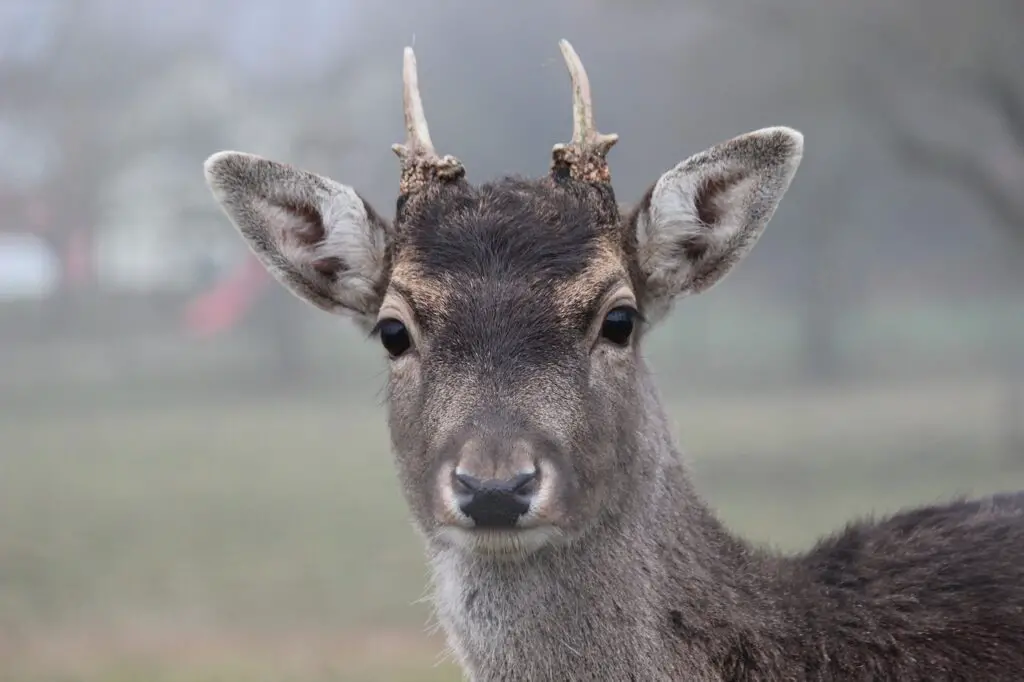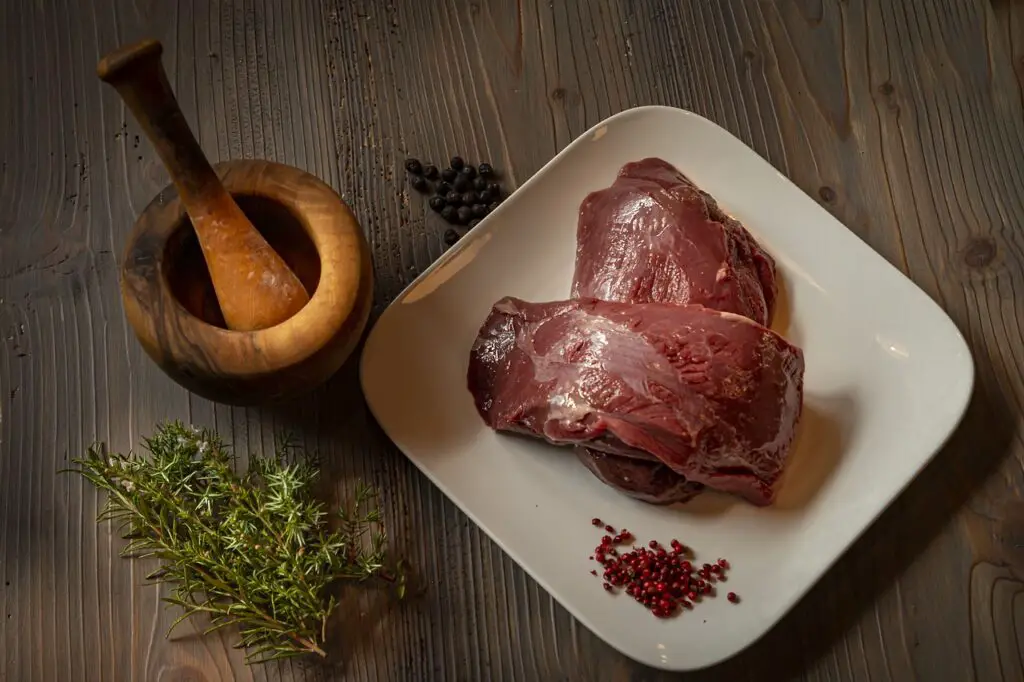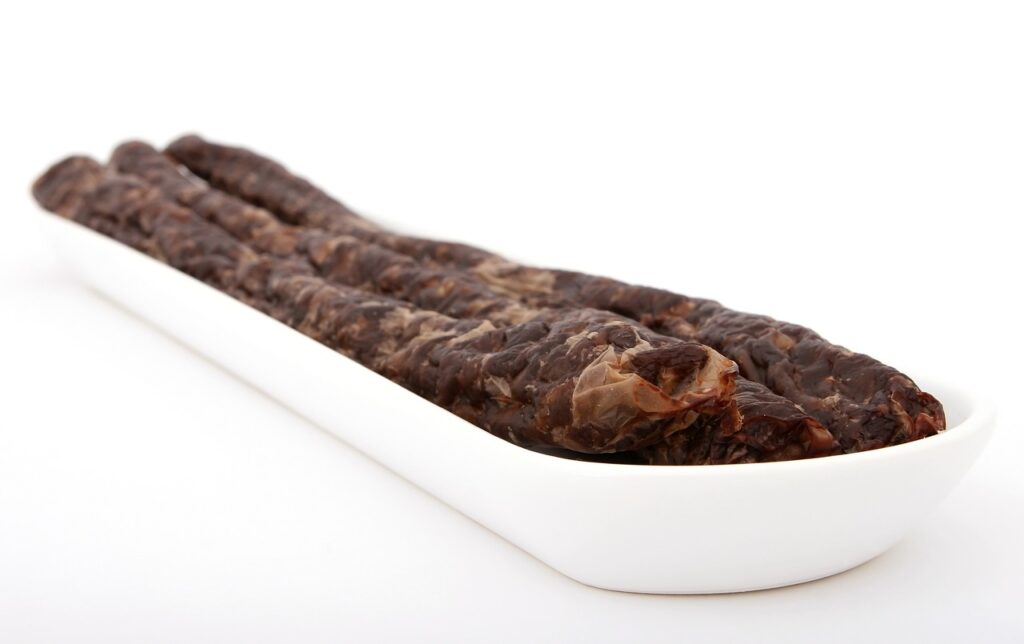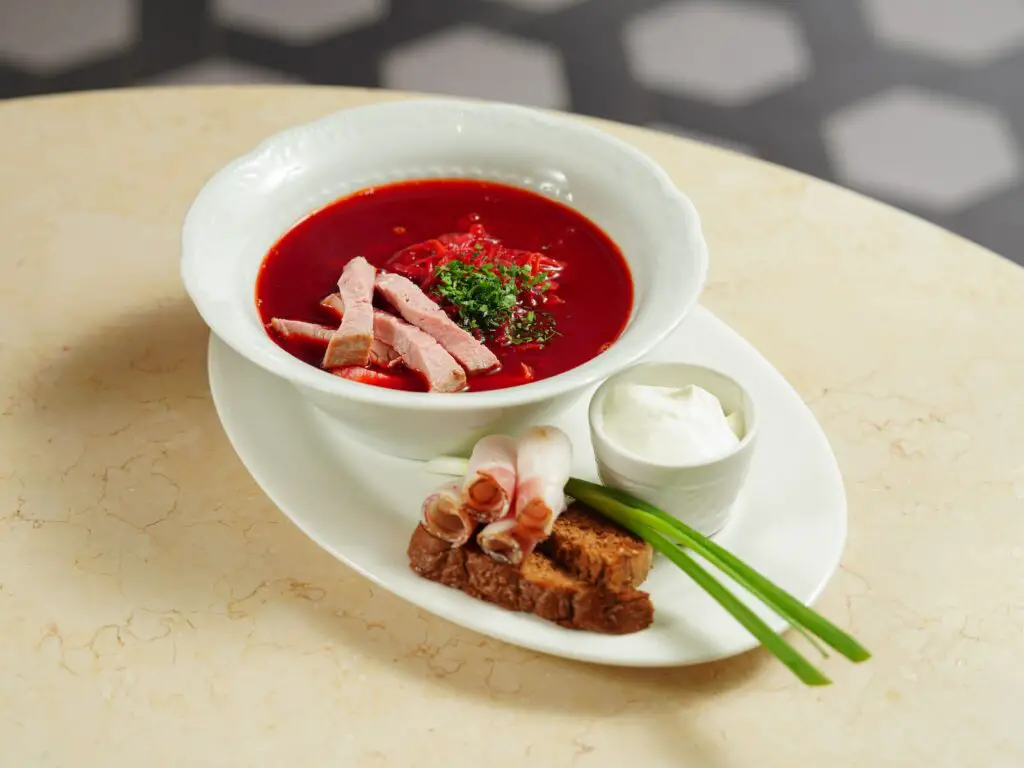
Deer meat is a popular delicacy among hunters and food enthusiasts. However, it is important to ensure that the meat is fresh and safe for consumption. Spoiled deer meat can cause food poisoning and other health complications. In this article, we will discuss how to tell if deer meat is bad and what to do if you suspect that your meat has gone bad.
One of the easiest ways to tell if deer meat is bad is by checking its appearance and smell. Fresh deer meat should have a bright red color and a slightly sweet smell. If the meat has a dull color or a foul odor, it may be spoiled. Additionally, if the meat has a slimy or sticky texture, it is a sign that it has gone bad. In such cases, it is important to discard the meat immediately to avoid any health risks.
Another way to tell if deer meat is bad is by checking its texture and taste. Fresh deer meat should be firm and have a slightly gamey taste. If the meat is mushy or has a bitter taste, it may be spoiled. It is important to note that cooking spoiled meat does not make it safe for consumption. Therefore, it is crucial to inspect the meat thoroughly before cooking or eating it.
Table of Contents
Understanding Deer Meat

Deer meat, also known as venison, is a popular type of game meat that many people enjoy. It is important to understand how to properly handle and store deer meat to ensure that it is safe to eat. Here are some key things to keep in mind when it comes to understanding deer meat:
- Muscle Structure: Deer meat is made up of muscle tissue, just like other types of meat. However, the muscle structure of deer is different from that of other animals. Deer muscles are longer and leaner, which can affect the texture and flavor of the meat.
- Doe vs. Buck Meat: The meat from a doe (female deer) and a buck (male deer) can have different flavors and textures. Doe meat is generally considered to be more tender and mild, while buck meat can be stronger and gamey.
- Handling and Storage: It is important to handle deer meat properly to prevent the growth of harmful bacteria. When field dressing a deer, it is important to keep the meat clean and cool. After hunting, deer meat should be refrigerated or frozen as soon as possible to prevent spoilage.
- Signs of Spoilage: It is important to be able to recognize the signs of spoiled deer meat. Some common signs include a sour or rancid smell, a slimy texture, or a change in color. If you notice any of these signs, it is best to err on the side of caution and discard the meat.
By understanding these key aspects of deer meat, you can ensure that you are handling and storing it properly and enjoying it safely.
Identifying Fresh Venison

When it comes to identifying fresh venison or fresh deer meat, there are a few things to look out for. Fresh venison should have a bright red color, and it should feel firm to the touch. The meat should also have a slightly sweet, gamey smell.
One way to tell if venison is fresh is to look at the color. Fresh venison will have a bright red color, similar to beef. If the meat has a dull or brownish color, it may not be fresh. However, it is important to note that the color of the meat can vary depending on the age of the animal and how it was processed.
Another way to tell if venison is fresh is to feel the meat. Fresh venison should feel firm to the touch, and it should not have any slimy or sticky residue. If the meat feels soft or slimy, it may not be fresh.
Finally, the smell of the meat can also indicate freshness. Fresh venison should have a slightly sweet, gamey smell. If the meat has a strong, unpleasant odor, it may not be fresh.
In summary, when identifying fresh venison or fresh deer meat, look for a bright red color, firm texture, and slightly sweet, gamey smell. If the meat has a dull color, soft texture, or strong odor, it may not be fresh.
Smell as an Indicator

One of the most reliable ways to tell if deer meat is bad is to use your sense of smell. A bad smell is usually a clear indicator that the meat has gone bad and should not be consumed.
When deer meat goes bad, it often develops a strong, gamey aroma that can be quite unpleasant. This smell is caused by the breakdown of proteins in the meat and the growth of bacteria. In some cases, the meat may also develop an earthy smell, which is caused by the presence of mold.
It’s important to note that not all gamey scents are a sign of bad meat. Venison, for example, has a distinct gamey scent that is considered desirable by many people. However, if the smell is particularly strong or unpleasant, it’s a good idea to err on the side of caution and avoid consuming the meat.
When checking the smell of deer meat, it’s important to use your senses carefully. Avoid getting too close to the meat and take a few deep breaths to get a sense of the overall aroma. If you detect any off-putting smells or an earthiness that seems out of place, it’s best to discard the meat and avoid consuming it.
In summary, the smell of deer meat is an important indicator of its freshness and safety for consumption. While some gamey scents are normal, a strong or unpleasant aroma is a clear sign that the meat has gone bad and should be avoided.
Touch and Texture
One of the best ways to determine if deer meat is bad is by examining its touch and texture. The texture of the meat can be a good indicator of its freshness and quality.
Fresh deer meat should have a firm and slightly springy texture when touched. It should not feel slimy or sticky to the touch. If the meat feels slimy or sticky, it may be an indication that it has gone bad.
Another important factor to consider is the structure of the meat. Fresh deer meat should be well-structured and hold its shape. If the meat appears to be falling apart or has a mushy texture, it may be a sign that it has gone bad.
When examining the texture of deer meat, it is also important to consider its tenderness. Fresh deer meat should be tender and easy to chew. If the meat feels tough or chewy, it may be an indication that it has been improperly stored or has gone bad.
In summary, the touch and texture of deer meat can be a good indicator of its freshness and quality. Fresh deer meat should have a firm, well-structured texture and be tender and easy to chew. If the meat feels slimy, sticky, or has a mushy texture, it may be an indication that it has gone bad.
Spoilage Signs
When it comes to deer meat, it is important to know how to identify signs of spoilage. Spoiled deer meat can cause food poisoning and other health problems, so it is crucial to be able to recognize when it has gone bad.
Here are some of the most common signs of spoilage to look out for:
- Color: Spoiled deer meat may have a green, black, or gray appearance. It may also have a grayish tint to it.
- Smell: Spoiled deer meat will have a strong, unpleasant odor. It may smell sour or putrid.
- Texture: Spoiled deer meat may feel slimy or sticky to the touch. It may also be dry and tough.
- Taste: Spoiled deer meat will have an off taste. It may taste sour or bitter.
If you notice any of these signs, it is best to discard the meat. Eating spoiled deer meat can lead to food poisoning, which can cause symptoms such as nausea, vomiting, and diarrhea.
It is important to note that spoiled venison may not always have obvious signs of spoilage. It is always best to err on the side of caution and discard any meat that looks or smells suspicious.
In addition to the signs listed above, it is important to properly store and handle deer meat to prevent spoilage. Keep it refrigerated or frozen until ready to use, and cook it to the appropriate temperature to ensure it is safe to eat.
Taste of Venison
The taste of venison can vary depending on various factors such as the age of the deer, its diet, and how the meat was prepared. Generally, venison has a rich, gamey flavor that is distinct from other meats like beef or pork.
Some people may find the gamey taste of venison to be too strong for their liking. However, this can be mitigated by adding certain flavors and seasonings to the meat. For example, adding salt, pepper, and sage can help to balance out the gamey taste and enhance the flavor of the meat.
It is important to note that venison should not taste sour, rancid, or spoiled. If the meat has a funky or off-putting smell or taste, it is likely bad and should not be consumed. When in doubt, it is better to err on the side of caution and discard the meat.
Overall, the taste of venison can be flavorful and delicious when prepared properly. By experimenting with different seasonings and cooking methods, you can find a way to enjoy this unique and nutritious meat.
Impact of Storage Conditions
The storage conditions of deer meat can significantly affect its quality and safety. Proper storage is crucial to prevent spoilage and ensure that the meat stays fresh and safe to eat. Here are some factors to consider when storing deer meat:
Temperature
Temperature is one of the most critical factors when it comes to storing deer meat. Meat should be stored at a temperature below 40°F to prevent bacterial growth. If the meat is not going to be consumed immediately, it should be stored in a refrigerator or freezer.
Refrigeration
Refrigeration is an effective method of preserving deer meat. Meat stored in a refrigerator should be wrapped tightly in plastic wrap or aluminum foil to prevent air exposure. It should also be placed on a plate or tray to prevent any juices from leaking onto other foods in the refrigerator. Refrigerated deer meat can last up to five days.
Freezing
Freezing is the best method for long-term storage of deer meat. Meat should be wrapped tightly in plastic wrap or aluminum foil and placed in an airtight container or freezer bag. It is important to remove as much air as possible to prevent freezer burn. Frozen deer meat can last up to six months.
Freezer Burn
Freezer burn occurs when the surface of the meat becomes dehydrated due to air exposure. This can cause the meat to become dry, tough, and tasteless. To prevent freezer burn, meat should be wrapped tightly in plastic wrap or aluminum foil and placed in an airtight container or freezer bag. It is also important to remove as much air as possible before freezing.
Room Temperature
Deer meat should never be left at room temperature for more than two hours. Bacteria can grow rapidly at room temperature, increasing the risk of foodborne illness. If deer meat has been left at room temperature for more than two hours, it should be discarded.
In conclusion, proper storage of deer meat is essential to ensure its quality and safety. Meat should be stored at a temperature below 40°F and wrapped tightly in plastic wrap or aluminum foil to prevent air exposure. Refrigeration is effective for short-term storage, while freezing is the best method for long-term storage. Freezer burn can be prevented by removing as much air as possible before freezing. Finally, deer meat should never be left at room temperature for more than two hours.
Effects of Aging and Freezing
When it comes to preserving deer meat, aging and freezing are two common methods that hunters use. However, these methods can have both positive and negative effects on the quality of the meat.
Aging
Aging is the process of allowing the meat to hang in a cool, dry place for several days before processing. This process allows the enzymes in the meat to break down the muscle fibers, resulting in a more tender and flavorful meat. However, if the meat is aged for too long, it can become tough and have a gamey taste.
Freezing
Freezing is another common method of preserving deer meat. Freezing the meat can help to extend its shelf life and prevent spoilage. However, freezing can also have negative effects on the quality of the meat. When meat is frozen, ice crystals form within the meat, which can cause damage to the muscle fibers and result in a tougher, less flavorful meat.
Frozen Deer Meat
If deer meat has been frozen for an extended period of time, it may develop freezer burn. Freezer burn occurs when the meat is exposed to air, causing it to become dehydrated and develop a dry, leathery texture. Freezer-burned meat is safe to eat, but it may not taste as good as fresh meat.
Moisture
Moisture is an important factor to consider when aging or freezing deer meat. If the meat is not properly dried before aging or freezing, it can develop mold or bacteria, which can cause spoilage and make the meat unsafe to eat.
Overall, aging and freezing can be effective methods of preserving deer meat, but they must be done properly to ensure that the meat remains safe to eat and retains its quality.
Concerns with Contamination
Contamination is a significant concern when it comes to deer meat. The meat can become contaminated with bacteria, which can lead to food poisoning. Food poisoning can cause severe symptoms such as vomiting, diarrhea, and fever.
One of the most common bacterial contaminants found in deer meat is Salmonella. Salmonella can cause food poisoning and is often found in undercooked or raw meat. It can also be found in the intestines of deer, which can contaminate the meat during processing.
Another bacterial contaminant that can be found in deer meat is Escherichia coli. This bacteria can cause severe food poisoning and is often found in undercooked or raw meat. It can also be found in the intestines of deer, which can contaminate the meat during processing.
It’s essential to handle deer meat carefully and cook it thoroughly to avoid contamination. Always wash your hands before and after handling raw meat, and use separate cutting boards and utensils for raw meat to avoid cross-contamination.
In conclusion, contamination is a significant concern when it comes to deer meat. Bacterial contaminants such as Salmonella and Escherichia coli can cause severe food poisoning, which can lead to severe symptoms. It’s essential to handle deer meat carefully and cook it thoroughly to avoid contamination.
Deer Meat and Chronic Diseases
Deer meat is a popular game meat consumed by many people all around the world. However, it is important to be aware of the potential risks associated with consuming deer meat, particularly when it comes to chronic diseases.
One of the most concerning chronic diseases associated with deer meat is Chronic Wasting Disease (CWD). CWD is a neurological disease that affects deer, elk, and moose. It is caused by an abnormal protein called a prion, which can be found in the brain, spinal cord, and other tissues of infected animals.
There is currently no evidence to suggest that CWD can be transmitted to humans who consume deer meat. However, it is recommended that hunters take precautions when handling and preparing deer meat to minimize the risk of exposure to CWD.
Another chronic disease that has been linked to the consumption of deer meat is Mad Cow Disease. This disease is caused by an abnormal protein called a prion, which can be found in the brain and spinal cord of infected cattle.
While there have been no reported cases of Mad Cow Disease in deer, it is important to take precautions when handling and preparing deer meat to minimize the risk of exposure to prions.
In summary, while there are potential risks associated with consuming deer meat, the likelihood of contracting a chronic disease is relatively low. By taking the necessary precautions when handling and preparing deer meat, hunters and consumers can minimize their risk of exposure to these diseases.
Proper Handling of Deer Meat
Proper handling of deer meat is crucial to ensure its safety and quality. Whether you are hunting, dressing, or processing deer meat, it is important to follow the best practices for handling and storing the meat.
When hunting deer, it is important to aim for a broadside shot to minimize the risk of damaging the meat. Once the deer is killed, it should be dressed as soon as possible to prevent the growth of bacteria. The deer should be hung by the hind legs to cool down and allow any remaining blood to drain out.
When processing the meat, it is important to keep everything clean and sanitized to prevent contamination. The tools and equipment used for processing should be thoroughly cleaned and disinfected before and after use.
To store deer meat, it should be kept at a temperature of 40°F or lower to prevent the growth of bacteria. If the meat is not going to be consumed within a few days, it should be frozen. When freezing deer meat, it is important to wrap it tightly in plastic wrap or freezer paper to prevent freezer burn.
In summary, proper handling of deer meat is essential for ensuring its safety and quality. Following the best practices for hunting, dressing, and processing deer meat can help prevent contamination and spoilage, allowing you to enjoy the delicious taste of venison.
Packaging and Preservation
Proper packaging and preservation are essential to ensure the quality and safety of deer meat. Here are some tips on how to preserve deer meat and prevent spoilage:
Packaging
When it comes to packaging deer meat, there are several options available. The most common methods include vacuum sealing, wrapping in butcher paper, or storing in plastic bags. Vacuum sealing is the preferred method, as it removes all the air from the package, preventing the growth of bacteria and fungi. Butcher paper is another excellent option, as it allows the meat to breathe, preventing the accumulation of moisture, which can lead to spoilage. Plastic bags are not recommended, as they can trap moisture, leading to bacterial growth.
Shelf Life
The shelf life of deer meat depends on several factors, including the packaging method, storage temperature, and the age of the animal. Vacuum-sealed deer meat can last up to two years in the freezer, while butcher paper-wrapped meat can last up to one year. If you choose to store deer meat in plastic bags, it will only last for a few months. It’s essential to store deer meat at a temperature of 0°F or below to prevent bacterial growth.
Preventing Spoilage
To prevent spoilage, it’s essential to handle deer meat properly. Always wash your hands thoroughly before and after handling meat. Keep the meat refrigerated or frozen until you’re ready to cook it. Thaw frozen deer meat in the refrigerator or under cold running water. Never leave the meat out at room temperature for more than two hours.
In summary, proper packaging and preservation are crucial to ensure the quality and safety of deer meat. Vacuum sealing or wrapping in butcher paper are the best options for packaging, and deer meat should be stored at 0°F or below. Always handle deer meat properly and take the necessary precautions to prevent spoilage.